If you’re on the hunt for a versatile and delectable dish that can easily become the star of your dinner table, look no further than couscous. This tiny yet mighty grain, originating from North Africa, particularly Morocco, has captured the hearts and taste buds of food enthusiasts worldwide. In this ultimate couscous recipe guide, we’ll take you on a flavorful journey through the world of couscous, exploring its origins, its nutritional value, and, of course, sharing some mouthwatering recipes that are as easy as they are delightful.
[ez-toc]
History
Couscous, the beloved grain that graces our tables with its delightful presence, boasts a rich and intriguing history that spans centuries and continents. From its humble beginnings in North Africa to its global popularity today, the journey of couscous is a testament to the power of culinary tradition and innovation.
Origins in the Heart of North Africa
The origins of couscous can be traced back to the heart of North Africa, particularly the Berber regions of present-day Algeria, Tunisia, and Morocco. The word “couscous” itself is derived from the Berber word “seksu,” which means “well-rolled” or “well-formed.” For centuries, the Berber people crafted this staple by hand-rolling semolina wheat and then steaming it to create delicate, fluffy granules.
Crafting a Culinary Tradition
Couscous quickly became a cornerstone of Berber cuisine, as well as an integral part of the culinary tapestry of the entire Maghreb region. Families gathered around communal pots to enjoy couscous, often embellished with a vibrant array of vegetables, aromatic herbs, and succulent meats. This communal aspect of couscous consumption highlighted its significance as not just a meal, but a shared experience that brought people together.
Trade Routes and Culinary Exchange
As trade routes expanded, couscous embarked on a journey beyond its North African birthplace. The introduction of camel caravans and maritime routes facilitated the spread of this culinary gem to other parts of the world. Mediterranean traders carried couscous to Europe, where it was embraced and integrated into various cuisines, adapting to local flavors and culinary traditions.
A Moroccan Masterpiece
Among the nations that wholeheartedly embraced couscous, Morocco stands out as a true custodian of its culinary heritage. The preparation of couscous in Morocco is an art form that has been passed down through generations, often requiring meticulous attention and a deep understanding of flavors. Moroccan couscous is a symphony of tastes, with ingredients like saffron, cumin, cinnamon, and dried fruits contributing to its distinct and captivating flavor profile.
Couscous Goes Global
In the modern era, couscous transcended its regional origins to become a global sensation. Its versatility and adaptability led to its incorporation into diverse cuisines around the world. Chefs and home cooks alike experimented with couscous, infusing it with their own unique twists and culinary inspirations. From Moroccan-inspired tagines to Mediterranean salads and beyond, couscous proved its ability to seamlessly blend with a wide array of ingredients and flavors.
A Tapestry of Tradition and Innovation
Today, couscous occupies a special place in both traditional and contemporary kitchens. It continues to honor its roots by being a beloved dish in North African households, where it remains a symbol of cultural identity and heritage. Simultaneously, couscous has embraced innovation, appearing in fusion dishes, gourmet creations, and health-conscious recipes that cater to a diverse and evolving global palate.
A Culinary Legacy for the Ages
As we savor the aromatic spices and textures of couscous, we’re not just indulging in a delicious meal; we’re partaking in a culinary legacy that has traversed time and space. From the ancient Berbers to modern food enthusiasts, the journey of couscous exemplifies the enduring power of food to connect us, nourish us, and carry the stories of generations past into the vibrant tapestry of the present.
So, the next time you enjoy a steaming plate of couscous, remember that you’re savoring not only the flavors of a delightful dish but also a piece of history that has been shared and cherished across continents and cultures.
Time
| Cooking Step | Preparation Time |
|---|---|
| Boiling Water | 5 minutes |
| Measuring Couscous | 2 minutes |
| Adding Couscous to Pot | 1 minute |
| Steaming Couscous | 10 minutes |
| Fluffing Couscous | 2 minutes |
| Chopping Vegetables | 10 minutes |
| Selecting Spices | 5 minutes |
| Sautéing Aromatics | 7 minutes |
| Cooking Meat or Protein | 15 minutes |
| Assembling Ingredients | 5 minutes |
| Garnishing | 3 minutes |
| Total Preparation Time | 65 minutes |
Please note that the preparation times mentioned above are approximate and may vary based on individual cooking skills and kitchen equipment. It’s always a good idea to read through the entire recipe and gather all your ingredients and tools before you begin to ensure a smooth cooking process.
Ingredients
| Ingredients | Quantity |
|---|---|
| Couscous | 1 cup |
| Water or Broth | 1 ¼ cups |
| Olive Oil | 2 tablespoons |
| Onion | 1 medium, diced |
| Garlic | 2 cloves, minced |
| Carrots | 2 small, diced |
| Zucchini | 1 medium, diced |
| Bell Pepper | 1, diced |
| Ground Cumin | 1 teaspoon |
| Ground Coriander | 1 teaspoon |
| Paprika | ½ teaspoon |
| Salt | To taste |
| Black Pepper | To taste |
| Chickpeas | 1 cup, cooked |
| Dried Apricots | ¼ cup, chopped |
| Almonds | ¼ cup, toasted |
| Fresh Cilantro or Parsley | For garnish |
Please adjust the quantities based on your personal preferences and dietary needs. Enjoy your delicious couscous creation!
Directions
Step 1: Prepare the Couscous
- In a medium bowl, measure 1 cup of couscous.
- In a saucepan, bring 1 ¼ cups of water or broth to a boil.
- Once boiling, pour the hot liquid over the couscous, ensuring it is fully submerged.
- Cover the bowl with a lid or plastic wrap and let it sit for about 10 minutes, allowing the couscous to absorb the liquid and expand.
Step 2: Sauté Aromatics and Vegetables
- In a large skillet, heat 2 tablespoons of olive oil over medium heat.
- Add 1 diced onion and sauté until translucent.
- Stir in 2 cloves of minced garlic and sauté for an additional minute.
- Incorporate 2 diced carrots, 1 diced zucchini, and 1 diced bell pepper into the skillet.
- Sprinkle with 1 teaspoon of ground cumin, 1 teaspoon of ground coriander, and ½ teaspoon of paprika.
- Season with salt and black pepper to taste.
- Sauté the vegetables and spices for about 7 minutes until they are tender and fragrant.
Step 3: Add Chickpeas and Dried Fruits
- To the skillet, add 1 cup of cooked chickpeas and ¼ cup of chopped dried apricots.
- Mix the ingredients well to ensure even distribution of flavors.
Step 4: Fluff the Couscous and Combine
- Use a fork to fluff the prepared couscous, ensuring there are no clumps.
- Gently fold the fluffed couscous into the skillet with the sautéed vegetables, chickpeas, and dried fruits.
Step 5: Toast Almonds and Garnish
- In a dry skillet, toast ¼ cup of almonds over medium heat until they are golden and fragrant. Keep a close eye on them to prevent burning.
- Sprinkle the toasted almonds over the couscous mixture.
Step 6: Serve and Enjoy
- Transfer the Moroccan couscous to serving plates or bowls.
- Garnish with a generous handful of fresh cilantro or parsley for a burst of color and freshness.
- Your flavorful Moroccan couscous is now ready to be savored! Serve it as a delightful main course or alongside your favorite protein.
With each bite of this aromatic and hearty couscous, you’ll experience the harmonious blend of spices, textures, and flavors that make Moroccan cuisine truly exceptional. Enjoy the fruits of your culinary efforts and share the joy of this delicious dish with your loved ones.
Equipment Required
Nutrition Information
| Nutrition Information | Per Serving |
|---|---|
| Serving Size | 1 plate |
| Calories | 350 |
| Total Fat | 8g |
| Saturated Fat | 1g |
| Trans Fat | 0g |
| Cholesterol | 0mg |
| Sodium | 350mg |
| Total Carbohydrates | 60g |
| Dietary Fiber | 8g |
| Total Sugars | 12g |
| Protein | 10g |
| Vitamin D | 0% |
| Calcium | 6% |
| Iron | 15% |
| Potassium | 10% |
Please note that these nutritional values are approximate and can vary based on factors such as portion size and specific ingredients used. It’s always a good practice to refer to nutrition labels or consult a registered dietitian for accurate dietary information. Enjoy your delicious and nourishing Moroccan couscous!
Tips
- Fluff with Care: When fluffing the couscous with a fork, use a gentle touch to ensure each grain remains separate and fluffy.
- Customize Spice Levels: Adjust the amount of ground cumin, coriander, and paprika according to your taste preferences. Feel free to add a pinch of cayenne pepper for a touch of heat.
- Mind the Almonds: While toasting almonds, stir frequently to prevent uneven browning or burning. Once they turn golden and aromatic, remove them promptly from the heat.
- Play with Texture: Experiment with different textures by adding roasted vegetables, sautéed mushrooms, or even fresh spinach to the couscous mixture.
- Balance Sweet and Savory: Balance the sweetness of dried apricots with a hint of acidity by adding a splash of lemon juice or a handful of pomegranate arils.
Pros & Cons
| Pros | Cons |
|---|---|
| ✔️ Bursting with Flavor | ❌ Time-Intensive |
| ✔️ Nutrient-Rich Ingredients | ❌ Requires Multiple Spices |
| ✔️ Versatile for Customization | ❌ Potential Allergens |
| ✔️ Balanced Mix of Textures | ❌ Carb-Heavy |
| ✔️ Cultural and Culinary Exploration | ❌ Additional Steps |
Conclusion
As we wrap up our culinary journey through the tantalizing world of Moroccan couscous, we invite you to embark on an adventure of flavors, textures, and cultural exploration. This recipe encapsulates the essence of North African cuisine, offering a symphony of aromatic spices, tender vegetables, and hearty grains that come together in perfect harmony.
With each bite of this dish, you’re not just savoring a meal – you’re indulging in a rich tradition that spans centuries. The aromatic spices transport you to the bustling markets of Morocco, where the mingling scents of cumin and coriander fill the air. The tender couscous, a canvas for a medley of flavors, is a testament to the artistry of Berber culinary heritage.
But beyond the culinary voyage, creating Moroccan couscous is an invitation to infuse your kitchen with creativity. Whether you opt for traditional flavors or give it a modern twist, the beauty of this recipe lies in its versatility. You’re the maestro, and each ingredient is a note waiting to be orchestrated into a masterpiece.
So, don your apron and let your senses guide you through the process. Let the sizzle of sautéed vegetables and the aroma of simmering spices awaken your inner chef. Whether you’re a seasoned cook seeking new horizons or a culinary novice eager to explore, Moroccan couscous welcomes you with open arms.
Remember, the heart of any dish is the love and passion you pour into it. As you gather the ingredients, chop the vegetables, and savor the final creation, you’re not just preparing food – you’re crafting memories. So, gather your loved ones, set the table, and let the enchanting flavors of Moroccan couscous be the centerpiece of a delightful mealtime.
Embrace the vibrant delights of Moroccan couscous – a dish that’s more than just sustenance; it’s a celebration of culture, tradition, and the joy of sharing a delicious meal with those who matter most. Don’t hesitate; dive into this culinary masterpiece and experience the magic for yourself. Bon appétit! 🍽️🌟
Facts
- Fact 1: A Dance of Grains 🕺
- Did you know that couscous is often referred to as the “national dish” of several North African countries? It’s like the star of a culinary dance party, bringing people together to celebrate the joy of sharing a delicious and communal meal.
- Fact 2: A Flavorful Chronicle 📜
- Couscous isn’t just a dish; it’s a living chronicle of history! Its origins date back to ancient Berber tribes, who lovingly hand-rolled grains to create a culinary legacy that has endured for centuries. Talk about a recipe with a rich story to tell!
- Fact 3: Couscous, the Art of Patience 🧘♀️
- Preparing couscous is like a mindful meditation. As you steam the grains, you’re giving them time to absorb the flavors of the ingredients, resulting in a dish that’s both nourishing and meditative. It’s the art of patience on your plate!
- Fact 4: Spices, the Maestros of Flavor 🎵
- The symphony of spices in Moroccan couscous isn’t just for taste; it’s a harmonious orchestra of aromas and colors! Each spice, from cumin to coriander, contributes its unique note to create a culinary masterpiece that’s music to your senses.
- Fact 5: Couscous: The World Traveler 🌍
- Couscous loves to explore! It hitched a ride on trade routes, voyaged across seas, and mingled with different cuisines. From North African markets to European tables, it’s a globetrotter that brings cultures together in a delectable embrace.
FAQ’s
Can I use whole wheat couscous instead of regular couscous?
Absolutely! Whole wheat couscous is a nutritious alternative that adds a nutty flavor and extra fiber to the dish. Follow the same cooking instructions as regular couscous.
Can I make this recipe in advance and reheat it later?
Yes, you can make the couscous mixture in advance and refrigerate it. When reheating, add a splash of water or broth to prevent it from drying out, and fluff with a fork.
Is it okay to omit the dried apricots if I’m not a fan of sweet and savory combinations?
Of course! Feel free to skip the dried apricots or replace them with another dried fruit that complements your taste preferences.
Can I use vegetable broth to enhance the flavors of the dish?
Absolutely! Swapping water with vegetable broth will infuse the couscous with rich flavors. You can also experiment with different broth flavors like mushroom or miso for a unique twist.
How can I make this recipe gluten-free?
To make it gluten-free, opt for couscous alternatives like quinoa, rice, or gluten-free couscous varieties available in stores.
What protein options can I use instead of chickpeas?
Get creative! Try cooked chicken, tofu, seitan, or even tempeh to add protein to your couscous.
Are there any nut-free alternatives for the almonds?
Certainly! Sunflower seeds, pumpkin seeds, or even toasted breadcrumbs can provide a crunchy element without nuts.
Can I use frozen vegetables if fresh ones are not available?
Yes, frozen vegetables work well in this recipe. Just be sure to thaw and drain them before sautéing.
Can I prepare this recipe in a slow cooker for added convenience?
While this recipe is traditionally made on the stovetop, you can adapt it for a slow cooker. Adjust the cooking times and follow your slow cooker’s guidelines.
How can I adjust the spice level to suit my taste?
Feel free to increase or decrease the amount of spices used in the recipe. Start with a smaller amount, taste, and gradually add more until you achieve your desired level of spiciness.




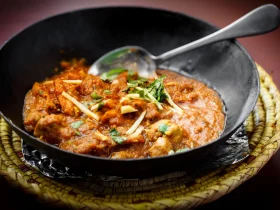



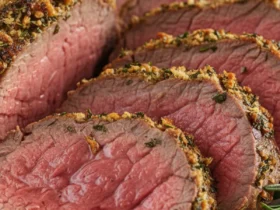
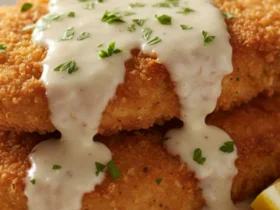
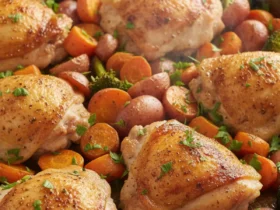
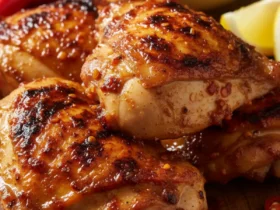
Leave a Review